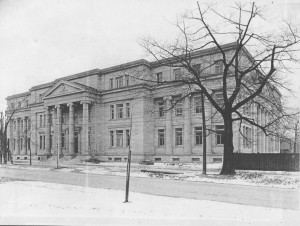The Lillian Massey Building, a historic building across from the Royal Ontario Museum, is the current home of the Centre for Medieval Studies.
Lillian Massey Treble (1854-1915), philanthropist and educator, was the daughter and joint heir of Hart Massey, founder of the Massey-Harris firm, the biggest manufacturer of agricultural machinery in the British Empire at the beginning of the last century. Devout Methodists, the family were generous patrons of the university—Hart House is named after Lillian Massey’s father and Massey College was a gift of the family—and keen social reformers. An early advocate of ‘scientific household management,’ Lillian Massey persuaded the university to institute a four-year degree programme in household science in 1905, which she endowed with a building to house the teaching staff, classrooms, laboratories, and recreational facilities for university women, including common rooms, a gymnasium and a swimming pool (the latter survives, preserved under a false floor).
Designed in the neo-classical style by Toronto architect George Miller, the building was begun in 1908, and opened five years later. Many of the lush interior fittings of marble and oak survive, as well as a sequence of magnificent Pre-Raphaelite stained-glass windows on the foyer staircase depicting the household arts. The windows are dedicated to Massey’s mother, Eliza Phelps:
Elissae Phelps Massey, fundatricis nostrae matri, et omnibus aliis feminis bonis, quae domos suas opibus domesticis ornaverunt, quorum ornamentorum et ipsae pars fuere maxima, hanc vitream honoris causa ponendam collocavit Lillian Massey Treble, kal. Oct. MDCCCCXV.
Considered the finest facility of its kind at the time in North America, the Lillian Massey Building housed the Department of Household Science until the 1970s, when it was absorbed by the Department of Nutritional Sciences in the Faculty of Medicine. Household Science is notable as the first University of Toronto unit to appoint female professors, including the founding principal Annie Laird and the organic chemist Clara Benson, the latter one of the first two women to receive a doctorate from the University of Toronto in 1903. It seems only appropriate that their building has been inherited in part by CMS, where female graduate students now represent more than half of our enrolment.
The Lillian Massey Building and some of its early students, around 1920:




_4.jpg)